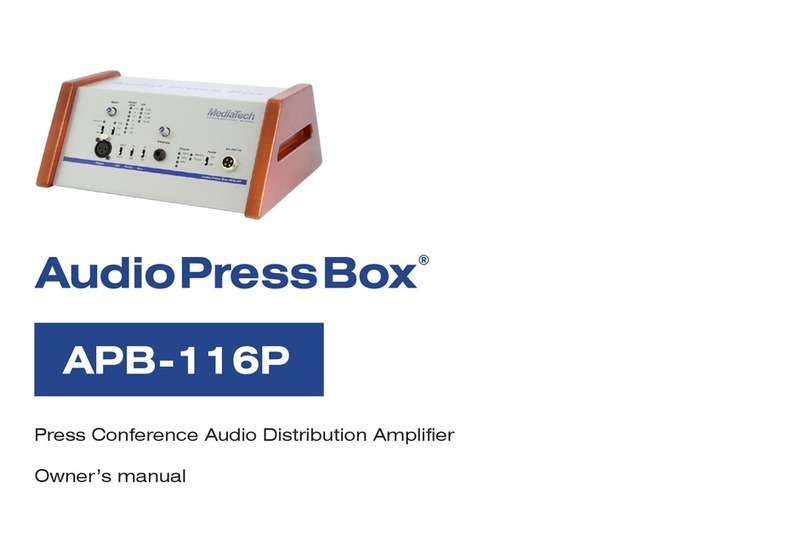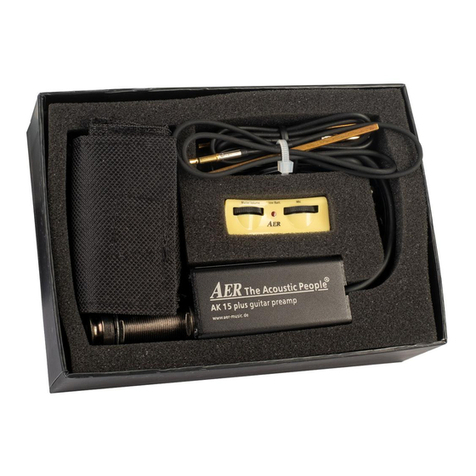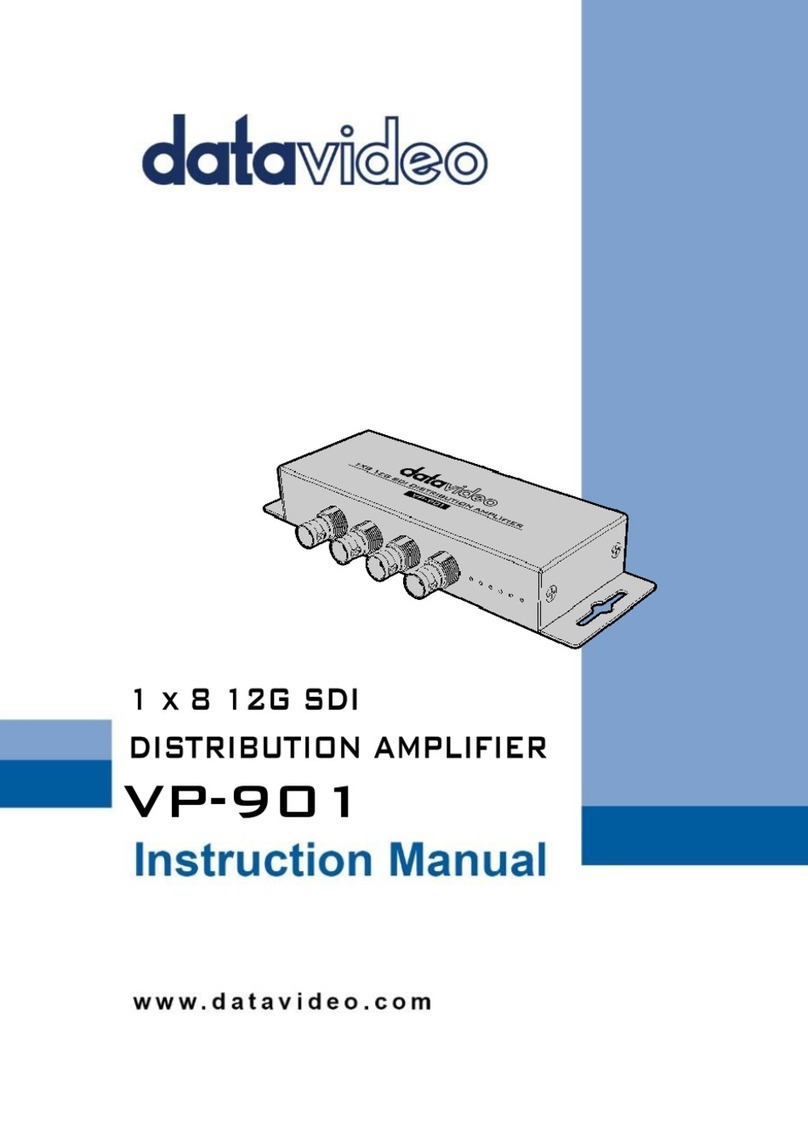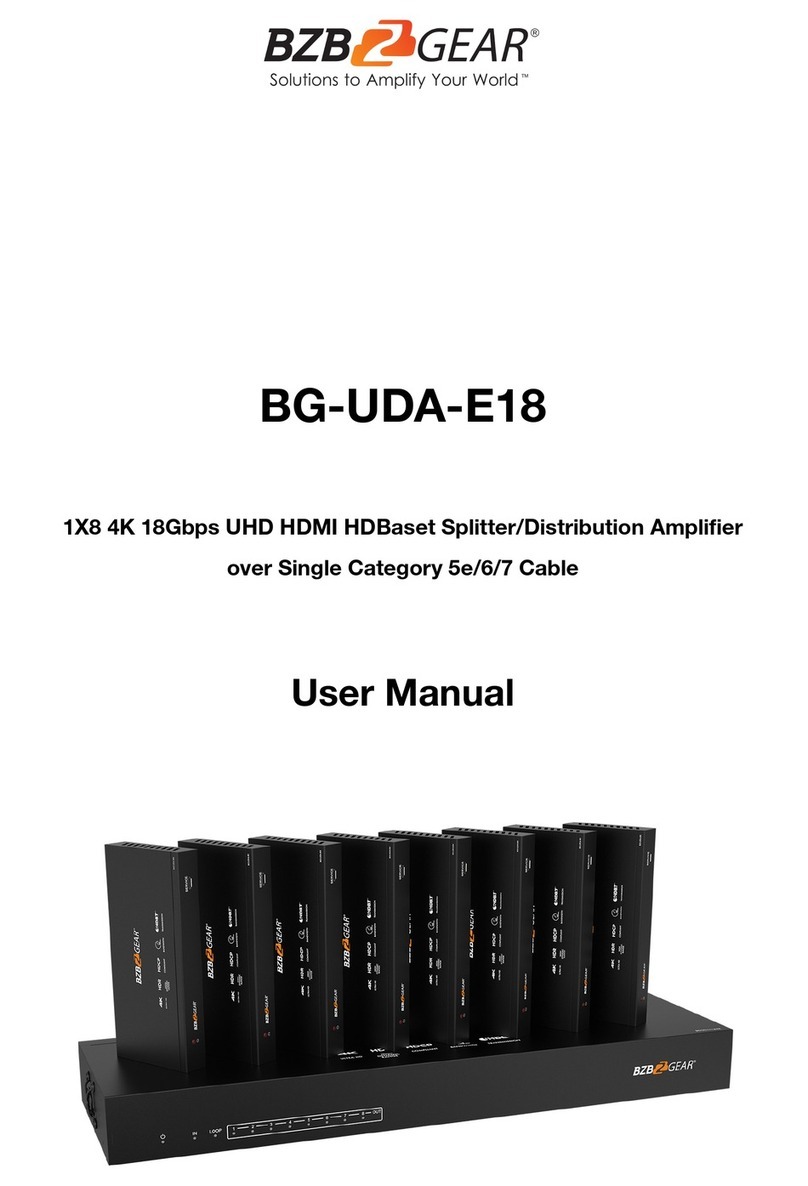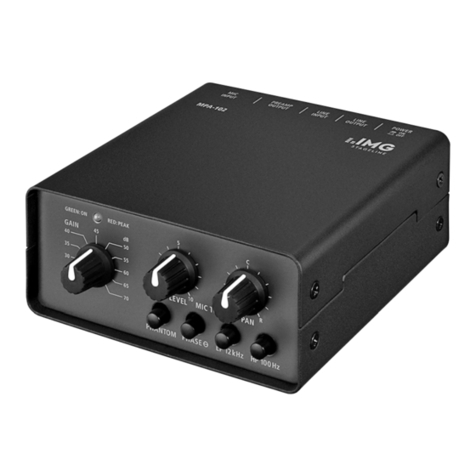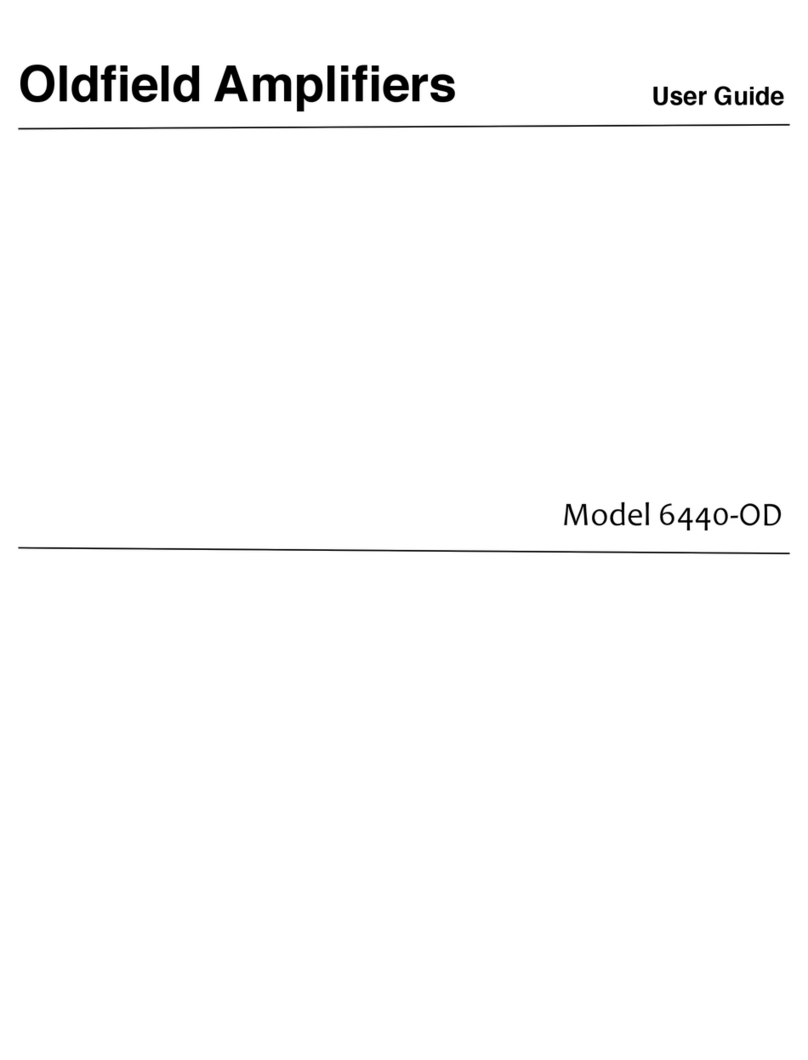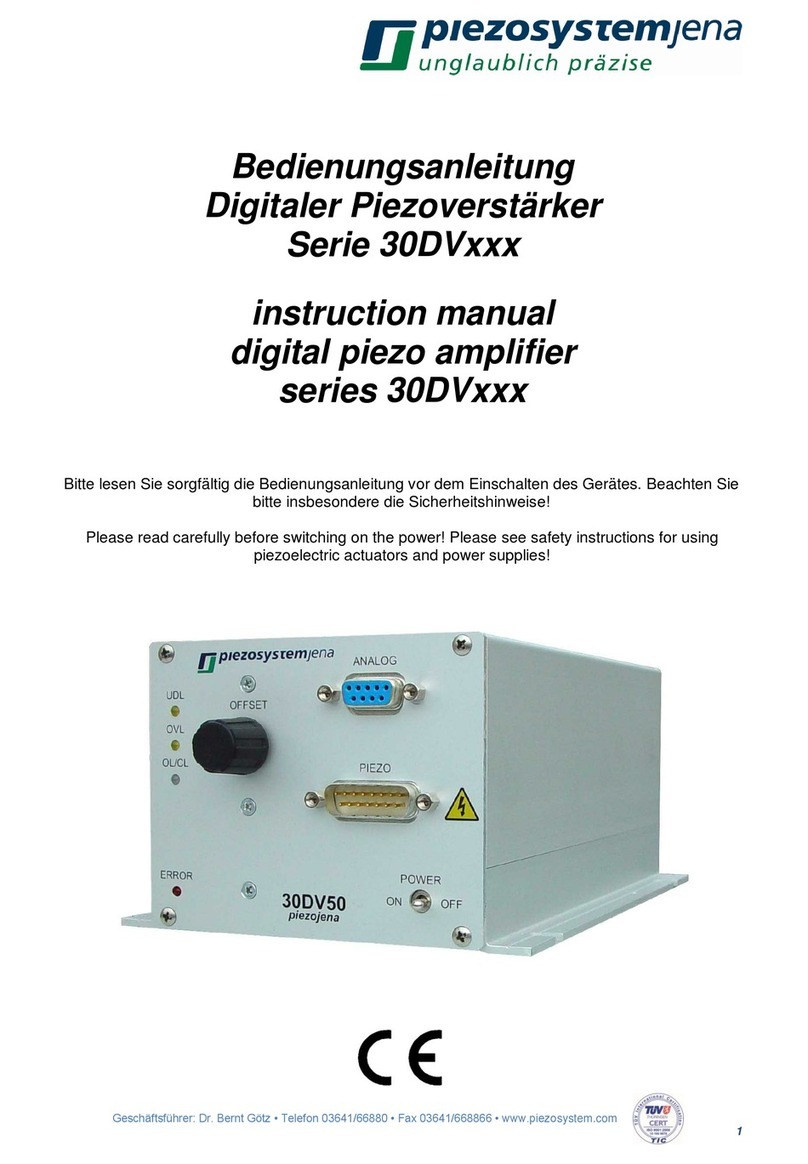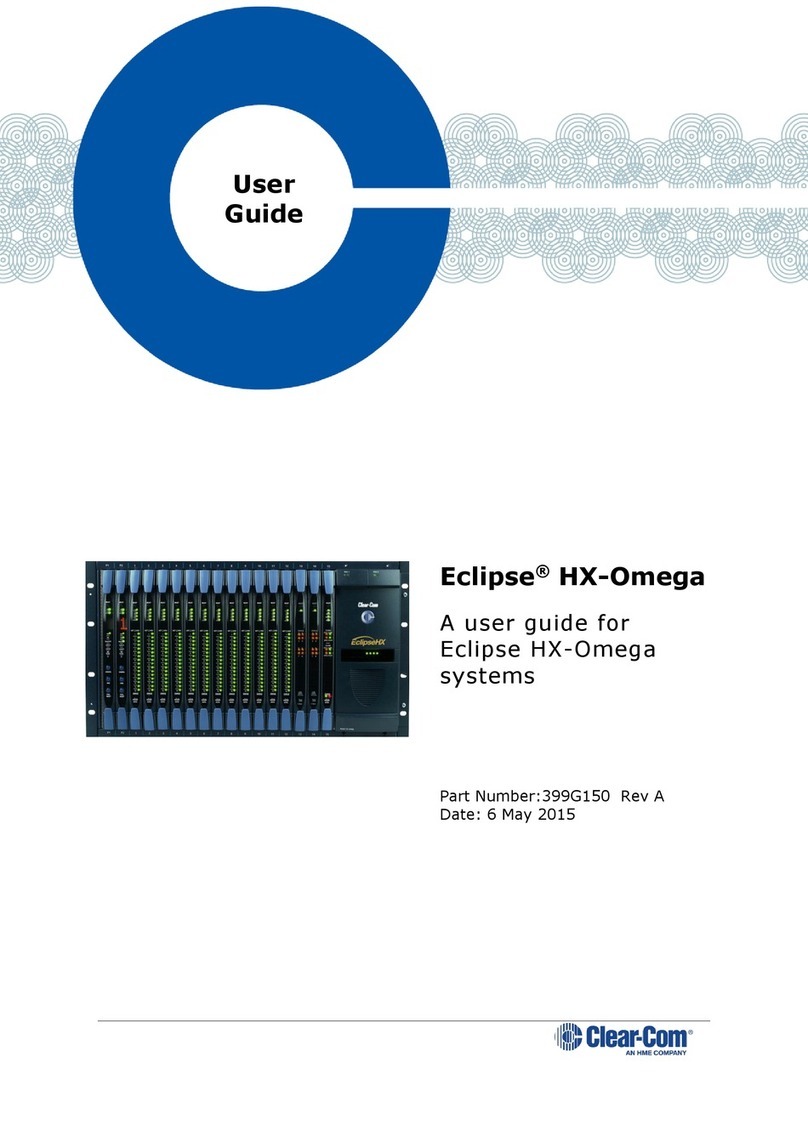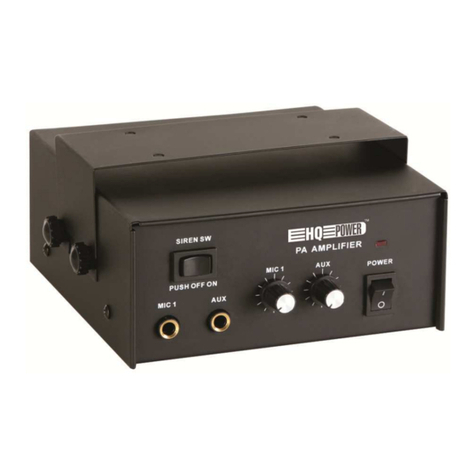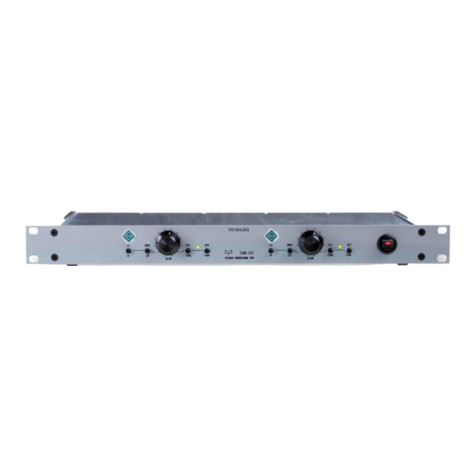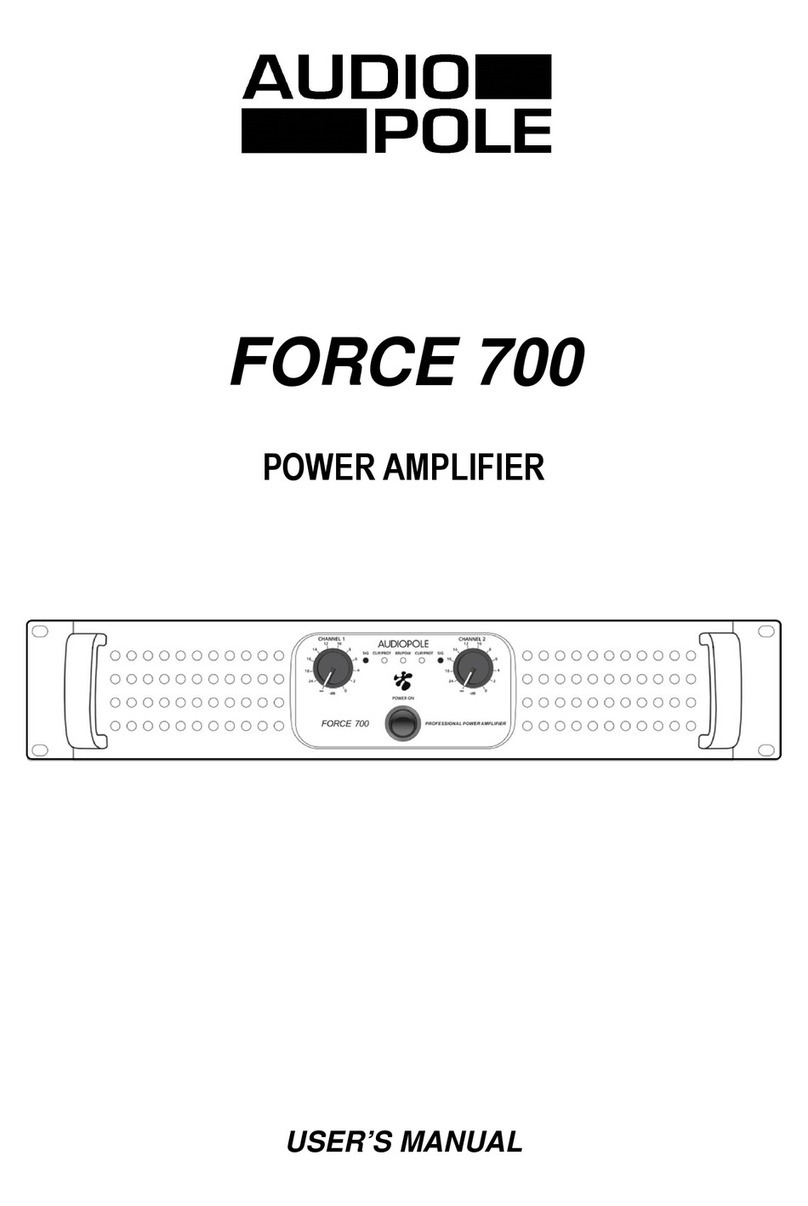BIO electronica sessantaquattro User manual

User Manual v 1.1
sessantaquattro
Portable bioelectrical signal amplifier
Read this manual carefully before using the sessantaquattro amplifier.

sessantaquattro user manual v1.1 - June 2017
pag. 2

sessantaquattro user manual v1.1 - June 2017
pag. 3
Index
1GENERAL DESCRIPTION ....................................................................................................... 4
2SESSANTAQUATTRO KIT CONTENT....................................................................................... 4
3END USER.............................................................................................................................. 5
3.1 CONTRAINDICATIONS ......................................................................................................................... 5
3.2 SIDE EFFECTS................................................................................................................................... 5
4SAFETY CAUTIONS AND OTHER WARNINGS ........................................................................ 6
5SYMBOLS USED ON SESSANTAQUATTRO AND IN THE USER MANUAL................................. 7
6TECHNICAL SPECIFICATIONS............................................................................................... 8
7DETAILED DESCRIPTION ....................................................................................................10
7.1 CONTROLS,INDICATORS AND CONNECTOR ............................................................................................. 10
7.1.1 INPUT AND RECHARGE CONNECTOR ...................................................................................................... 10
7.1.2 ON/OFF SWITCH ............................................................................................................................ 11
7.1.3 MICROSD CARD SLOT....................................................................................................................... 11
7.1.4 LEDS INDICATORS........................................................................................................................... 11
7.1.5 START/STOP REC PUSHBUTTON.......................................................................................................... 13
8USE OF SESSANTAQUATTRO ............................................................................................... 14
8.1 SESSANTAQUATTRO WIFI INTERFACE ................................................................................................... 14
8.2 SIGNALS ....................................................................................................................................... 15
8.3 ELECTRODE AND RECHARGE ADAPTERS .................................................................................................. 16
8.4 WIRELESS DATA TRANSFER ................................................................................................................ 21
8.5 MICROSD DATA LOGGING.................................................................................................................. 22
8.6 WEBPAGE SETUP ............................................................................................................................. 23
8.7 PATIENT CONNECTION ...................................................................................................................... 27
9TROUBLESHOOTING ........................................................................................................... 28
10 SESSANTAQUATTRO MAINTENANCE AND STORAGE .......................................................... 29
11 TECHNICAL CHARACTERISTICS.......................................................................................... 30
12 WARRANTY ......................................................................................................................... 31
12.1 WARRANTY CONDITIONS ................................................................................................................... 31

sessantaquattro user manual v1.1 - June 2017
pag. 4
1GENERAL DESCRIPTION
The sessantaquattro is a multichannel amplifier and datalogger for bioelectrical signals. It can
detect surface electromyographic (sEMG) signals and electroencephalographic (EEG) signals.
The sessantaquattro allows the detection and recording of the electric signals generated by human
body. The signals acquired by the instrument are amplified, filtered, digitally converted and then
transferred to a PC, through a WiFi connection, for real-time visualization and storage or stored in
a MicroSD card. A freeware software for real time display and storage, called OT BioLab, has been
designed by OT Bioelettronica and is available for download on the website
www.otbioelettronica.it, under the download page.
The sessantaquattro is a research instrument designed for clinical research carried out by qualified
researchers. It is completely safe for the patient. The safety is achieved by satisfying the design
requirement for devices with an electronic part applied to the patient.
Sessantaquattro has different adapters for the connection to different electrode configurations.
Each of them makes also available two inputs for auxiliary signals.
2SESSANTAQUATTRO KIT CONTENT
1 portable multichannel amplifier sessantaquattro
cable adapters to connect electrodes to the amplifier;
1 conductive cream package;
3 reference straps for the ankle;
3 reference straps for the wrist;
3 reference cables;
1 USB cable type A-C;
Arrays and matrix of electrodes of different sizes, depending on the customer request;
1 sessantaquattro user manual.

sessantaquattro user manual v1.1 - June 2017
pag. 5
3END USER
Sessantaquattro multichannel amplifier allows non invasive recording of biopotentials (sEMG, EEG)
detected by superficial electrode.
The end user must be familiar with the technique and received a proper training in EMG or EEG
detection and interpretation.
3.1 Contraindications
Sessantaquattro has no particular contraindications when used jointly with personal computers,
provided that all the electrical devices connected to it comply with safety rules and standards
concerning grounding and leakage currents.
3.2 Side effects
No significant side effects are known. The materials used for manufacturing all the parts in contact
with the patient are biocompatible. Possible slight cutaneous allergic reactions (e.g. skin
reddening) are reduced to a minimum during short duration of bioelectrical signal acquisitions.

sessantaquattro user manual v1.1 - June 2017
pag. 6
4SAFETY CAUTIONS AND OTHER WARNINGS
The use of the multichannel amplifier sessantaquattro is absolutely forbidden in the following
conditions:
While other monitoring devices are in use with the patient.
While electro surgery equipment, short waves or microwaves therapy devices are used.
By mentally impaired people.
Whenever the equipment is damaged.
In proximity of inflammable substances (especially inflammable liquids and gases) or in
environments with high concentration of oxygen.
On patients carrying life-supporting equipment that might be adversely affected by
electromagnetic interferences, such as pacemakers, etc.
The following cautions should be observed:
Only use electrodes supplied by the manufacturer: sessantaquattro is guaranteed to achieve
tested performance only if used with electrodes supplied by the manufacturer.
Contact the manufacturer immediately if extraneous materials permeate into the device
(liquids, powders, etc.). In case of hard shocks suffered by the sessantaquattro (like a drop to
the floor, etc.), verify that no crack or any other kind of damage of the box resulted from the
shock. In case of doubt, please contact the manufacturer.
The sessantaquattro is subject to electromagnetic interference that is not dangerous for the
patient (such as electrostatic or electromagnetic interference generated by electrical motors
and other sources). This interference may affect the measurements of the physiological
variables derived from the EMG or EEG signals. These measurements are not meant to be
used for diagnostic purposes, and thus these signal alterations cannot be dangerous for the
patient, please always take into account the presence of noise in your signal processing tasks
and evaluations.
The connection between sessantaquattro and other electrical devices must be done in
compliance with the European standard EN 60601-1-1 on medical devices.
The use of the sessantaquattro is restricted to skilled personnel.
Incorrect measurements can arise when unskilled personnel use the device in presence of
strong sources electromagnetic interference (e.g. strong electromagnetic fields). The presence
of interference in the signals is easily recognised by skilled personnel.

sessantaquattro user manual v1.1 - June 2017
pag. 7
5SYMBOLS USED ON SESSANTAQUATTRO AND IN THE USER MANUAL
Class BF for circuitry applied to patient.
Read carefully the instruction remarks before use.
Signals input.

sessantaquattro user manual v1.1 - June 2017
pag. 8
6TECHNICAL SPECIFICATIONS
Sessantaquattro is a battery powered device designed to guarantee an high safety level for the
patient and the operator in all operating conditions. The insulation between sessantaquattro and
the PC for real time data display and storage, is intrinsically achieved by the wireless data transfer
and communication. The same connector is used for electrode interface and battery recharge
avoiding the chance to supply the quattrocento from an external source when it is connected to
the patient.
The connector for the auxiliary inputs is intended for the interface with other floating devices
(goniometers, accelerometers or amplifiers for other biological signals). The connection must be
done in compliance with the European standard EN 60601-1-1 on medical devices.
Table 6.1 shows the list of available adapters and their connections.
Adapter
Available connections
CUSB01SE
USB type C, for battery recharge
AD8x1SE
Eigth four poles 3.5 mm jacks for connection of two bipolar electrode pairs (16
electrodes pairs in total). An additional four poles 3.5 mm jack for two auxiliary
signals. A 2 mm female banana for the patient reference connection.
AD1x16SE
A 16 pin connector for linear electrode arrays. An additional four poles 3.5 mm
jack for two auxiliary signals. A 2 mm female banana for the patient reference
connection.
AD2x32SE
Two 32 pin connectors for 32 electrode matrixes. An additional four poles 3.5
mm jack for two auxiliary signals. A 2 mm female banana for the patient
reference connection.
AD1x64SE
A 70 pin connectors for 64 electrode matrixes or 64 electrode EEG caps. An
additional four poles 3.5 mm jack for two auxiliary signals. A 2 mm female
banana for the patient reference connection.
TAB. 6.1: list of sessantaquattro available adapters.
Additional adapter can be realized under user request to interface other type of electrodes or
sensor.

sessantaquattro user manual v1.1 - June 2017
pag. 9
Sessantaquattro technical specifications are shown in TAB. 6.2.
EMG/EEG channels
Number of channels
64
Gain
1, 2, 4, 8 V/V
Low pass filter
~ FSAMP/4
High pass filter
DC coupled or 10 Hz digital
Noise level referred to input
4 VRMS
Input resistance
500 M
Input range
0 –3.3 V
Auxiliary channels
Number of channels
2
Gain
0.5 V/V
Low pass filter
~ FSAMP/4
High pass filter
DC coupled
Noise level referred to input
4 VRMS
Input resistance
500 M
Input range
± 3.3 V
Data conversion and communication
A/D converter resolution
16, 24 bits
A/D converter input dynamics
± 2.4 V
Selectable sample frequency
500, 1000, 2000, 4000 Hz
Data transfer to PC
WiFi through TCP socket
Data storage
MicroSD
TAB. 6.2: sessantaquattro technical specification

sessantaquattro user manual v1.1 - June 2017
pag. 10
7DETAILED DESCRIPTION
Sessantaquattro is a battery portable equipment for acquisition of surface EMG and EEG. Signals
can be transferred to a PC for real time display and recording or directly stored on a MicroSD card
by the device. The device can act as a WiFi acces point or connect to an existing network provided
by an external access point. In both cases, sessantaquattro has an IP address where a web page
can be reached using any browser, for configuration, control and firmware update.
Data transfer to a PC is obtained through a TCP socket opened by the PC. A configuration string
sent to sessantaquattro can set all the acquisition parameters and start the data transfer. The
communication protocol is available for custom development together with demonstration Matlab
code.
7.1 Controls, indicators and connector
Sessantaquattro can be fully configured by means of its internal web page, while the LEDs and
button just provide a quick access to basic functions.
FIG. 7.1: Sessantaquattro controls, connectors and indicators.
7.1.1 Input and recharge connector
The 80 pins connector is the interface between sessantaquattro and its adapters. The different
adapters allow to connect the device with different type of electrodes and sensors or to recharge
the battery. The pinout of the connector is available on request for custom developments. Refer to
section 8.3 for additional details about the available adapters.

sessantaquattro user manual v1.1 - June 2017
pag. 11
7.1.2 ON/OFF switch
This switch turns on and off the sessantaquattro by completely remove the battery supply from all
its parts. Always move the switch in the OFF position when the device is not used to avoid battery
discharge.
7.1.3 MicroSD card slot
This socket accepts MicroSD card formatted as FAT16 or FAT32 to use the sessantaquattro as a
datalogger. The acquisition can be started with the Start/Stop REC pushbutton if enabled or
through commands on the WiFi. Refer to section 8.5 for additional details about the data recording
on the MicroSD card.
7.1.4 LEDs indicators
The three LEDs are used to identify the state of sessantaquattro. Each of them reflect the state of
a different activity of the device:
-The white LED is related to the wireless data transfer
-The blue LED report the state of the data logging
-The red LED highlight errors or problems
The three LEDs are independent and the information provided from each one is displayed cyclically
by a given number of blink.
In Table 7.1 the different states and related number of LEDs blinks are highlighted.
N. of blinks
White LED
Blue LED
Red LED
1
WiFi active
Waiting for a trigger
Data lost during wifi transfer
2
Connected to a network
Recording data on SD
MicroSD card error
3
Connected to a TCP socket
-
Low battery
4
Transferring data
-
-
TAB. 7.1. Relation between the number of blinks of each LED and sessantaquattro states.
White LED
This LED indicates the state of the WiFi and data transfer through a TCP socket. Slightly different
information are provided depending on the role of sessantaquattro.

sessantaquattro user manual v1.1 - June 2017
pag. 12
When acting as an access point: a) one blink of the white LED indicates that the network has been
generated and is available for a connection by another device; b) two blinks indicate that a device
is connected to the network generated by sessantaquattro.
When configured to connect to an external WiFi network: a) one blink indicates that
sessantaquattro is active and is searching for one network; b) two blinks indicate that
sessantaquattro has successfully connected to an external network.
Regardless of the sessantaquattro role, three blinks indicate that sessantaquattro is connected as a
client to a TCP socked generated by a server device (usually the PC used for real time data display
and recording); four blinks indicate that sessantaquattro is transferring data through the TCP
socket to a server.
Using OT BioLab software the three blinks condition is never visible because the TCP socket is
opened when pressing the button of data transfer and, as soon as sessantaquattro is connected to
the socket, the data transfer begins. The three blinks condition can be useful for custom
development in the debugging phase to understand when the TCP socket is correctly created and
sessantaquattro is connected to it.
Blue LED
The blue LED reflect the state of the data logging on the MicroSD card. All the settings for the data
logging can be provided to sessantaquattro using the internal web page, including how to control
the start and stop recording.
One blink of the LED indicates that the recording on MicroSD card has armed and sessantaquattro
is waiting for the triggering event to start the recording. The typical trigger event to start a
recording is pressing the button, but more option are available using the configuration string sent
to sessantaquattro through the TCP socket. When starting an acquisition directly from the internal
web page or with the configuration string, the 1 blink state does not occur and the recording start
directly.
Two blinks of the blue LED reflect that data storing on the MicroSD card is in progress.
Red LED
The red LED is used to alert the user of an error or a critical condition.
One blink indicates that samples has been lost in the wireless data transfer. This happen when the
sessantaquattro internal data buffers are full and the transmission of data packet is not possible.
The acquisition of the next signal sample will create a reset of the internal data buffer with the loss
of an amount of data equal to the data buffers size (refer to section 8.2 for additional details).

sessantaquattro user manual v1.1 - June 2017
pag. 13
If this condition is temporary (e.g. sessantaquattro for a limited time is too far from the PC for the
acquisition), and then the data transfer restart properly the red LED will stop to blink. The data
loss in recorded data can in any case be verified offline by checking one of the accessory channel
(see section 8.2 for additional details).
Two blinks of the red LED indicate an error in the process of the MicroSD data recording. Typical
condition that generate this error are: MicroSD not inserted, MicroSD not formatted as FAT16 or
FAT32, maximum file size larger than the maximum contiguous space on the MicroSD. This error
condition persist until another data recording on MicroSD card starts successfully or until another
type of error occur.
Three blink of the red LED correspond to a battery level lower than the 20%.
Please note that there is no priority in the error reporting and always the last error detected
generates the number of blinks of the red LED. For example, if a data recording on the MicroSD
produce an error and then an error on data transfer happen, the LED will indicate the error related
to the data transfer until it persist (because it happen later). As soon as the wireless
communication restart properly, the LED will indicate no error. In general, the low battery level will
prevail on the other error conditions, simply because the battery level is monitored quite
frequently and continuously.
7.1.5 Start/Stop REC pushbutton
The sessantaquattro pushbutton has the main function to start and stop the data recording on the
MicroSD. It can be activated/deactivated from the internal web page or by means of the
commands sent through the TCP socket. The option to deactivate the pushbutton has been
introduced to avoid the possibility to accidentally press the button during a long time data
recording and stop involuntarily the data logging.
A second function of the pushbutton is obtained if it is pressed for about 5 seconds at the device
power on. In this condition, all the three LEDs start flashing simultaneously for four times and the
sessantaquattro role is forced to be “access point”. This feature can be really helpful if
sessantaquattro has been configured as a station connecting to an external WiFi network, but no
one of the networks in the sessantaquattro list is available. In this particular condition, the device
cannot be reached for any type of communication and the only way to access it again is the use of
this secondary function of the pushbutton.

sessantaquattro user manual v1.1 - June 2017
pag. 14
8USE OF SESSANTAQUATTRO
The sessantaquattro can be interfaced to any computer with a network interface and running any
kind of operative system. This manual refers to the use of sessantaquattro together with PC with
Windows and the freeware software OT BioLab. In case a different type of operative system is
used, or if the user interface needs to be customized the configuration and communication
protocol of sessantaquattro is available as Matlab examples. Please contact OT Bioelettronica to
receive the additional manual and examples.
8.1 Sessantaquattro WiFi interface
The WiFi interface available for sessantaquattro is similar to the interface available for other
devices like printers, routers or access points. As any other device connected to a network,
sessantaquattro has its own IP address. When sessantaquattro is connected to a network (with the
same IP range of the PC) it is accessible for data transfer, ping or configuration, through its web
configuration page.
It can act as an access point or can connect to a WiFi network generated from other access points.
In the default factory settings, sessantaquattro generate a WiFi network open (with no password)
with name “sessantaquattro” and act as a DHCP server providing the settings to the devices that
are connected to the network. The sessantaquattro default IP address, when it act as access point,
is 192.168.1.1, with subnet mask 255.255.255.0. When successfully connected to the network
generated by sessantaquattro, typing the IP address on any browser the internal configuration
page will be displayed (refer to section 8.6). The configuration page allows to check the device
current settings and to change all the parameters.
A list of networks, and relative password to access them, can be saved in the internal flash
memory of sessantaquattro (refer to section 8.6). When the sessantaquattro is configured to
connect to an external WiFi network, at start-up, it try to connect to one of the network in its list
and, when successfully connected, it starts to blink the white led twice. In this condition a service
called mDNS running on sessantaquattro can be used to find its IP address. OT BioLab software
make available a button in the configuration window to directly open the sessantaquattro web
page. Another option is to use a free software called
Bonjour
that will receive the mDNS message
displaying the sessantaquattro IP address.

sessantaquattro user manual v1.1 - June 2017
pag. 15
8.2 Signals
The natively resolution of sessantaquattro is 24 bits obtained by sampling the signals with a
sigma-delta A/D converter. The signals are acquired DC coupled and the only hardware filtering is
a simple antialiasing filter at 154 kHz. The low pass filter is imposed by the sampling frequency
and is about ¼ of the sampling frequency. The acquisition with all the 24 bits is intended for EEG
signals DC coupled to a maximum sampling frequency of 1 kHz. For the EMG data collection a
firmware high pass filter is implemented (only on the bioelectrical signals, not on the auxiliary)
removing the DC component and moving the signals baseline to the middle scale of the dynamic.
This condition make possible the acquisition of the EMG signals with a reduced 16 bits resolution.
The data format in both cases, 24 bits and 16 bits, is little endian.
The A/D converters have differential inputs that allows the positive and negative inputs to swing
between ± 2.4 V. The positive input is fed with the signals from the electrodes, the negative
signals are connected to the patient reference, the midpoint of the power supply. The least
significant bit (LSB) of the signals is obtained by:
LSB = ADCRANGE/224 = 286.1 nV
On the standard adapters, that have the jack connector for the collection of the two auxiliary
signals, a simple circuit allows to extend the input range to ± 3.3 V by increasing the LSB value to
572.2 nV. An additional extension factor on the bioelectrical analog signals can be added (only in
custom development, not using OT BioLab) to increase the input range when the 16 bits resolution
is used, with values of 2, 4, 8. When the 16 bits resolution is set, only the 16 less significant bits
are transferred for the bioelectrical signals and only the 16 most significant bits are transferred for
the AUX signals. This introduce a limitation in the signal range for the bioelectrical signals to
18,75 mVPP and a limitation in the resolution for the auxiliary signals with an LSB of 146,48 µV.
Condition
Input Range
LSB
Noise RMS R.T.I.
Noise P-P R.T.I.
16 bits, BioSig
18,75 mV
286.1 nV
0.6 –1.2 µV
3.6 –7.8 µV
16 bits, Ext = 2, BioSig
37.5 mV
572.2 nV
0.9 –1.8 µV
5.7 –12.1 µV
16 bits, Ext = 4, BioSig
75 mV
1.144 µV
1.6 –3.2 µV
9.8 –22.2 µV
16 bits, Ext = 8, BioSig
150 mV
2.289 µV
3 –6.1 µV
17.9 –41.8 µV
24 bits, BioSig
2,4 V
35.7 nV
0.6 –1.2 µV
3.6 –7.8 µV
16 bits, AuxSig
6,6 V
146,48 mV
3 –6.1 µV
17.9 –41.8 µV
24 bits, AuxSig
6,6 V
572.2 nV
3 –6.1 µV
17.9 –41.8 µV
TAB. 8.1. Characteristics of acquired signals with different settings. The noise range is related to different
sampling frequencies.

sessantaquattro user manual v1.1 - June 2017
pag. 16
Table 8.1 summarize the different input ranges, LSB values, RMS and peak to peak noise with the
different acquisition settings for bioelectrical and auxiliary signals.
Additionally to the biological and auxiliary signals, two accessory channels are added to the signals
set both when data is transferred through the WiFi and when the signals are recorded on the
MicroSD card. These two channels represent the internal buffer usage and a sample counter. The
buffer usage indicates how many words (i.e. 2 bytes) are currently in the internal buffer waiting to
be written on the MicroSD card or sent through the WiFi. The internal buffer size is 90 kBytes,
thus, values around 45000 on the buffer usage, indicate that the internal buffer is full. The sample
counter is incremented every sample and can be used to check if some sample has been lost. It
ranges from -32768 to 32767 and then restart from -32768.
8.3 Electrode and recharge adapters
The different adapters essentially provide access to the 80 pins input connector. Each adapter is
intended for the connection to a particular electrodes type or for the battery recharge. A
predefined detection mode is associated to each adapter. Detailed description of each adapter are
highlighted in the following section.
CUSB01SE
It is the adapter for the sessantaquattro battery recharge. The supply can be provided with a USB
type C cable connected to a PC or to a wall DC adapter, like the ones used for any smartphone.
When connected to a PC, please check the PC power supply setting to ensure that it won’t enter
the standby mode during the recharge and interrupting it.
The red LED on the top of the CUSB01SE indicates, when it is on, that the battery recharge is in
progress and, when it turns off, that the recharge is completed.
The integrated circuit that controls the battery recharge is in the adapter itself and implement
different recharge technique depending on the battery level: battery conditioning, constant current
and constant voltage. The constant current phase is the one that last longer and produce a more
efficient battery recharge. The recharge current is internally set to about 300 mA.
Providing the recharge voltage through the adapter avoid the patient connection while the device
is also connected to an external power supply source.

sessantaquattro user manual v1.1 - June 2017
pag. 17
FIG. 8.1. The CUSB01SE adapter.
AD8x1SE
This adapter allows the connection of up to 8 electrodes pair through four four-poles 3.5 mm
jacks. The signal detected from the 16 electrodes feed the positive inputs of the first 16 channels.
The patient reference, available on the adapter as a 2 mm female banana connector, has to be
placed using a reference strap or a large electrode to the patient body on a place without
bioelectrical activity. At the same time, this electrode fix the common mode patient body potential
to the midpoint of the power supply of sessantaquattro and feed the negative inputs of all the
channels.
FIG. 8.2. The AD8x1SE adapter.
This adapter is intended for the detection of 8 bipolar signals obtained as a difference between
each electrode pair. The differences are estimated from the microcontroller by subtracting, sample
by sample, the A/D conversions generated from the channels corresponding to each electrodes

sessantaquattro user manual v1.1 - June 2017
pag. 18
pair. Figure 8.3 shows the 3.5 mm jack pinout to interface the two electrode pair to the
sessantaquattro.
FIG. 8.3. Four poles 3.5 mm jack connector pinout for the connection of two electrode pairs to the AD8x1SE
adapter.
Additionally to the EMG signals, the AD8x1SE allows the connection of two auxiliary signals
through a fifth jack connector. This connector can also provide a 3.3 V output voltage to
eventually supply external circuits.
FIG. 8.4. Four poles 3.5 mm jack connector pinout for the connection of two auxiliary signals to the
AD8x1SE adapter.
Pair 2 –Negative electrode
Pair 1 –Negative electrode
Pair 2 –Positive electrode
Pair 1 –Positive electrode
GND
AUX IN1
AUX IN2
3.3 V

sessantaquattro user manual v1.1 - June 2017
pag. 19
There is no a particular limit for the current supplied by this output voltage, but it is intended for
small loads, in the order of few tens of milliamps. This voltage is also the voltage used for the
internal analog circuits supply, thus, unregulated absorption can generate noise on the biopotential
signals. Figure 8.4 shows the pinout of the auxiliary input connector.
The input swing for the AUX IN signals is ± 3.3 V. Refer to section 8.2 for further details about the
AUX IN signals conversion.
AD1x16SE
This adapter can be used to acquire signals from a 16 electrode linear array. The connector make
available the standard interface for any linear array produced from OT Bioelettronica: dry and
adhesive arrays with different interelectrodic distances (refer to our website for a complete list).
FIG. 8.5. The AD1x16SE adapter.
Like for the other electrodes adapters, the AD1x16SE make available on a 2 mm female banana
connector the patient reference. It has to be placed using a reference strap or a large electrode to
the patient body on a place without bioelectrical activity. At the same time, this electrode fix the
common mode patient body potential to the midpoint of the power supply of sessantaquattro and
feed the negative inputs of all the channels. The acquisition of the 16 signals is natively monopolar
with respect to the patient reference, but online or offline differences between signals detected
from adjacent electrode can be estimated generating the differential signals.

sessantaquattro user manual v1.1 - June 2017
pag. 20
A four pole 3.5 mm jack connector allows the simultaneously recording of two auxiliary channels
together with the EMG signals. Refer to figure 8.4 for the pinout of the connection and to the
description of the AD8x1SE for additional details about the auxiliary channels.
AD2x32SE
The AD2x32SE make available two connection towards 32 electrode matrixes. A single model of 4
row and 8 column is available as standard electrode, but additional shapes and sizes can be
designed on request. The two adapter branches are labelled with 1 and 2 indicating witch matrix
will be connected to the first 32 channels and wich to channels 33 to 64.
FIG. 8.6. The AD2x32SE adapter.
The patient reference connection is available on a 2 mm banana connector as well as two
additional auxiliary inputs. Refer to previous described adapters for further details about patient
reference connection and auxiliary inputs.
AD1x64SE
The AD1x64SE make available a connection for 64 electrode matrixes. Different electrode matrixes
types, sizes and shapes are available, refer to our website for a complete list.
The patient reference connection is available on a 2 mm banana connector and as well as two
additional auxiliary inputs. Refer to previous described adapters for further details about patient
reference connection and auxiliary inputs.
Table of contents
